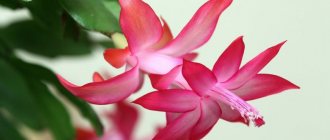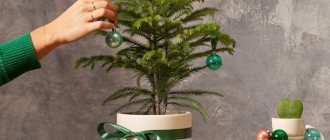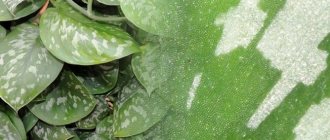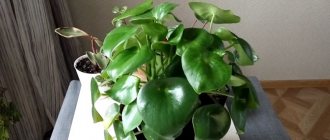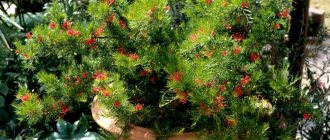floravdome.ru > Araceae > Top 20 Scindapsus species photo varieties + rare
Epipremnum pinnatum (pinnatum) in nature (Photo - macroid.ru)
Scindapsus (Scindapsus) - evergreen climbing vines from the tropics of Southeast Asia, Indonesia, Polynesia and even the north of Australia. Scindapsus belongs to the large and diverse Araceae .
In the natural environment, scindapsus are powerful plants; their thick stems wrap around huge tropical trees, growing up to 40 meters or more. Aerial roots help them cling to tree bark and obtain nutrients from it. The leaves of adult plants can grow up to half a meter! But this only happens in the native tropics. At home, the size of scindapsus is much more modest, but with good care you can easily grow a five-meter vine.
Scindapsus and epipremnum differences
In recent years, many species that were classified as Scindapsus are now classified as Epipremnum . The differences between these two species are insignificant and work on classification is still underway, but for now for gardeners these names are synonyms and are used interchangeably.
The main difference, visible to a non-specialist, is the presence of aerial roots and their rudiments . In scindapsus, aerial roots are located only in the nodes, and in epipremnums - along the entire length of the stem.
It is also worth noting that work on the study of plants continues, and the classification is constantly updated and refined.
The difference between scindapsus and epipremnum is its aerial roots (Photo - Olga Nikonorova/vk.com/terra_doma)
In nature, there are about 25 varieties of scindapsus. Their differences from each other are in the shape and color of the leaves. In terms of growing conditions, they are practically no different.
For indoor and home cultivation, 6 species and varieties or hybrids are used, bred by breeders on their basis.
I would like to note that some varieties have very little difference between each other, and if you want to purchase a plant of a certain specific variety, it is better to do this in specialized nurseries or from collectors who can accurately classify the plant.
Let's look at the main types and varieties of scindapsus:
Scindapsus pictus or Scindapsus pictus
A very popular and widespread species.
The adult leaf is matte dark green with a thin white edge. Silvery-white spots of various sizes are scattered across the entire surface of the leaf. A characteristic feature of the species is the asymmetry of the leaves relative to the central vein.
Under good conditions and high humidity, scindapsus leaves can grow up to 15 cm.
Scindapsus pictus
Varieties of scindapsus pictus (painted) :
Scindapsus Argyraeus
A popular variety of scindapsus painted. Wide small leaves with small white spots.
Scindapsus pictus Argyraeus
Scindapsus Pictus Trebie
A common variety - large asymmetrical leaves with a light contrasting pattern - spots, strokes, stripes. The leaf is slightly embossed, the surface of the leaf is velvety. Unpretentious, shade-tolerant, but the brightness of the pattern depends on the intensity and duration of lighting.
Scindapsus pictus Treble
Scindapsus Pictus Silvery Ann or Satin Pothos
Silvery spots almost completely cover the matte green surface of the leaf. Of all the varieties of Scindapsus painted, Silver Ann has the most extensive coverage of spots of the main green background. Sometimes the surface of the sheet appears completely silver.
Scindapsus Pictus Silvery Ann
Lighting
Scindapsus is a shade-tolerant plant, but prefers bright, diffused light. Variegated varieties especially need it. In the shade, the pattern on the foliage may disappear.
Scindapsus must be protected from direct sunlight from March to September . Otherwise, the leaves fade and fall off.
Epipremnum will feel good at a distance of 0.5-2 meters opposite a well-lit window. In winter, it is recommended to place it as close to the window as possible.
The plant develops normally under artificial lighting with fluorescent or phytolamps. In this case, both in winter and summer he needs to create a 10-hour daylight hours.
Golden scindapsus (Scindapsus aureus) or Epipremnum aureus (Epipremnum aureus)
The most common type of scindapsus in indoor floriculture.
An unpretentious liana with bright leaves grows rapidly, fits into any interior, does not require much attention, with the exception of regular watering and periodic pruning. The more light the plant receives, the brighter the pattern on the leaves and the more intense the color. In shade and partial shade, golden scindapsus acquires a uniform dark green color.
In the USA, Scindapsus aureus is called "golden pothos" (pothos is another plant from the araceae family with confusion in classification).
Golden scindapsus (Scindapsus aureus)
Varieties of golden scindapsus:
Scindapsus Golden Queen Golden Queen
The leaf is a bright, rich green color, on which there are golden-yellow strokes, spots and stripes, often merging with each other. Similar colors appear in daily sunlight. With a lack of light, the leaf acquires a uniform green color.
Scindapsus aureus Golden Queen
Scindapsus Marble Queen
Coloring – white strokes and stripes densely, almost completely cover the dark green color of the base. In good lighting, white becomes the predominant color in the color; some leaves can grow completely white.
Scindapsus Marble Queen
Scindapsus N'Joy
A young Dutch variety that quickly gained popularity. The leaf is small, compared to other varieties, more rounded. Color – dark green base covered with white streaks. The leaves are contrasting and look very bright and elegant. If you plant several cuttings in a pot, the flower will grow into a dense, dense compact bush. It is recommended to grow as a hanging plant.
It grows well in partial shade, but the more light, the brighter the pattern and the larger the leaf.
Scindapsus N'Joy
Scindapsus Neon or Epipremnum Golden Neon or Golden Pothos
Large, up to 10 cm leaves on long petioles. The color of the leaves is a bright luminous light green. At home it can grow up to 5 meters, so it requires support or constant pruning.
Scindapsus Neon
Scindapsus Exotica
Heart-shaped leaf with a relief surface. The color is matte green with silver streaks from the central vein to the edges.
Scindapsus Exotica
Scindapsus = Epipremnum Moonlight
Similar to Exotica , but the leaves are narrower, dark green, single-colored with a distinct silvery tint.
Scindapsus Epipremnum Moonlight
Scindapsus = Epipremnum Jessina
Marble coloring - the leaf is densely covered with strokes and stripes of yellow color. Outwardly similar to Marble Queen , but Marble Queen has a lighter color, and Jessina has golden-yellow-green shades.
Scindapsus = Epipremnum Jessina
Scindapsus Marble Apple Marble Apple
The rounded leaves are dark green in color with watercolor “bays” of light green, white, and cream. Light areas may include green flecks.
Scindapsus Marble Apple Marble Apple
Scindapsus Manjula or Happy Leaf (Scindapsus= Epipremnum Manjula, Happy Leaf)
The leaves are large, heart-shaped, multi-variegated - a mixture of green, pale light green, cream and white flowers interspersed with green, often with a silvery tint. Similar to Marble Apple , but the leaf is more rounded and the edge of the leaf is wavy.
Scindapsus Epipremnum Manjula, Happy Leaf
Scindapsus Jade (Scindapsus= Epipremnum Jade) Jade
Heart-shaped shiny leaves of dark green color.
Scindapsus Jade (Scindapsus=Epipremnum Jade) Jade
Scindapsus Pearl & Jade Pearl and Jade
White-green variegation from the middle of the leaf to the edges. Light areas may contain inclusions. The leaf is smaller and does not grow quickly.
Scindapsus Pearl & Jade Pearl and Jade
Types and varieties
The species of scindapsus are very similar to each other, differing in the presence or absence of spots and streaks. These spots can be white, yellow, or lemon-colored. There are also some differences in the size of the leaves and the length of the shoots. Let's look at the types of scindapsus that are popular in indoor floriculture.
Golden
Golden scindapsus is most often found among gardeners. It is distinguished by decorative bright green leaves with yellow stripes and spots. In addition to its visual appeal, this species is distinguished by its unpretentiousness in cultivation. Therefore, it can often be found not only in apartments, but also in offices. The size of the leaves varies from six to twelve centimeters.
In indoor floriculture, Golden scindapsus is represented by the following varieties:
Golden Queen
Marble Queen
- "Golden Queen" with leaves that have more yellow than green;
- 'Marble Queen' has predominantly white leaves;
- The “Tricolor” variety is distinguished by the fact that yellow and cream spots are scattered on a green background.
Painted
Its leaves, growing up to fifteen centimeters, are distinguished by a matte gray-green color. Silver spots are scattered across the main background. The edge of the leaves is edged with a silver stripe. The shoots can grow up to three meters in length. It is distinguished by asymmetrical leaves, in which one side is smaller than the other.
Pinnate
Scindapsus neon
This type of vine has smooth dark green leaves measuring ten to twenty centimeters. Pinnate scindapsus is also distinguished by the shape of its leaves, pointed at the ends. Their size increases with the age of the plant. In the sun, the color of the leaves brightens. The variety Scindapsus pinnate Neon stands out for its bright green leaves with a lemon tint.
This may be interesting: Description of types and varieties of Tradescantia
Siamese
Scindapsus siamese also has asymmetrical leaves. But its leaf plates are large in size and covered with spots, stripes, and streaks of silver and light green. Southeast Asia is considered the homeland of the Siamese scindapsus.
Troiba
Perakensis
Among the rare species of decorative vines, we note Scindapsus Troiba and Scindapsus Perakensis, which can only be found in the collections of experienced gardeners. Scindapsus Perakensis is distinguished by smooth, monochromatic, arrow-shaped green leaves. At the base of the leaf blade there are leaf appendages resembling small wings. Scindapsus Troiba also has narrow leaves, pointed at the edges. It has a slow growth rate.
Scindapsus perakensis
A rare species with shiny long arrow-shaped leaves of rich green color. Unpretentious and shade-tolerant.
Scindapsus Perakensis
Interesting varieties of the species Scindapsus Pinnatum = Epipremnum Pinnatum
The leaves of plants of this species, as they grow older, split naturally in the same way as those of scindapsus relatives in the aroid family - monstera, syngonium, philodendron.
Due to the external similarity of adult leaves, sometimes confusion occurs with the definition of not even the variety, but the type of plant!
Description
Scindapsus is a perennial evergreen that uses other trees as support for its growth. The vine has several types of roots:
- aerial roots for attaching to a support;
- aerial roots to obtain nutrients from the air;
- underground roots.
The genus Scindapsus includes about thirty species. Many species grown in indoor floriculture are divided into several varieties bred by gardeners.
The leaves of the plant are oval-shaped, pointed at the end, and come in a variety of colors. Many varieties have spots and streaks of white, yellow, and silver on the leaf blades. The leaves of scindapsus have a clearly defined central vein.
In nature, the vine blooms, throwing out small ears covered with a blanket. In indoor floriculture, scindapsus does not bloom , but this does not detract from its attractiveness for breeding. The liana is used to decorate walls, placing it in a hanging pot, or placing supports in the form of an arch along which it weaves. To get a dense bush, several cuttings are planted in one pot.
Scindapsus pinnatum varieties:
Scindapsus Mosstok = Epipremnum Mosstok
A rare species of scindapsus with large leaves with yellow streaks on a light green background. Mature leaves are dissected into segments.
Scindapsus Epipremnum Mosstok
Scindapsus pinnatum Skeleton key (Scindapsus pinnatum = Epipremnum pinnatum Skeleton key)
An interesting and unusual Thai variety. Small leaves of rich green color change to an unusual shape as they mature, “growing” a long arrow-shaped process at the end.
Scindapsus pinnatum Skeleton key (Photo - Etsy.com)
Scindapsus Cebu Blu = Epipremnum pinnatum Cebu Blue
Narrow elongated leaves are bluish-green in color with a metallic sheen. With bright light and good care, mature leaves naturally split into random segments.
Scindapsus Cebu Blu = Epipremnum pinnatum Cebu Blue
Scindapsus = Epipremnum pinnatum Albo Variegata
A rare variety with large, up to 40 cm, heart-shaped leaves that split as they mature. The variegation is clear - white strokes, stripes, spots, segments on a bright green background. English name: White Variegata
Scindapsus pinnatum Albo Variegata (Scindapsus = Epipremnum pinnatum Albo Variegata)
Scindapsus of different types and varieties are equally unpretentious and grow well with minimal care. But in order to get a beautiful and healthy plant, and also not to have unnecessary troubles in the future, you need to immediately provide the minimum suitable conditions for the flower.
You can read the full article on caring for scindapsus here .
Firstly, the location . Scindapsus grow well in the shade, but most ornamental variegated varieties show the beauty of their leaves in bright, long-lasting light. In the shade, their colors fade and the leaves become uniformly green. This is especially true for variegated (variegated) varieties of golden scindapsus - golden queen, marble queen and others. Painted scindapsus is more resistant to partial shade. The plant should be shaded from direct sunlight; only morning light is permissible.
Another important factor when placing the plant is the absence of drafts, sudden temperature changes and cold air currents. In winter, just one draft can be detrimental to a plant.
Scindapsus are heat-loving and grow well at an average temperature of +20° - 23°. In winter, it is permissible to lower the temperature to an average of +18o, but not lower than +15o. +12o is the critical threshold. In summer, scindapsus tolerate short-term increases up to +30o well, but in such weather they require additional spraying and more frequent watering.
Scindapsus (Epiprumnum) popular varieties: Golden Queen, Marble Queen, N-Joy, Neon
Secondly - watering . As natives of the humid tropics, scindapsus require regular watering. The signal for watering is the drying of the top layer of soil by 2-3 cm. In summer, watering is required frequently, in winter - less often. It is not recommended to allow the earthen coma to dry out completely. Also destructive is the “flooding” of the plant, stagnation of moisture in the pot, and acidification of the soil. This will inevitably lead to rotting of the roots. For irrigation, use only water that has been standing for at least a day. It is better if the water is 2-5 degrees warmer than room temperature.
As additional moisture, you can regularly spray the plants , although they tolerate average indoor air humidity normally. But in dry air and winter, spraying is required. In summer, a warm shower is recommended as additional care. If the plant is located near a window, then after a shower it is recommended to dry it completely before putting it back.
Scindapsus pinnatum = Epipremnum pinnatum Varieties: Cebu Blue and Alba Variegata
Pest and disease control
Due to dry air, the leaves curl and dry, so place trays with wet expanded clay and spray the vine. But from an excess of moisture, the shoots begin to rot, as well as from too low a temperature. Then the scindapsus needs to be replanted, trimmed and dried.
Fungal diseases are the most common problem of scindapsus. All moisture-loving plants encounter it. There is only one rule here - remove all damaged areas and use fungicides. And in the future, adjust the temperature and humidity conditions.
Scindapsus suffers quite often from pests. Especially from spider mites and scale insects. Gently wipe the leaves with alcohol or soapy water, and remove as many parasites as possible with a cotton pad. After that, use insecticides.
Photo: zelenj.ru
Date palm (50 photos): types, care and cultivation at home
Transplantation of scindapsus
Transplantation of scindapsus is done once a year for young plants. The pot must have large drainage holes, and a drainage layer must be placed on the bottom. soil . The main thing is that it allows moisture to pass through well.
Usually several cuttings are planted in one pot. Scindapsus can be grown as hanging plants, but to make caring for them easier, it is better to place a support in the center of the pot, or next to the plant. This will allow the plant to grow upwards unhindered and eliminate the need for constant trimming of excessively long hanging vines.
Feeding 2 times a month with complex fertilizer for decorative deciduous plants will have a positive effect on the growth and appearance of the plant.
Caring for scindapsus at home
Caring for any type of scindapsus is almost the same and, in general, the vine is considered an unpretentious plant. Let's look at the most important things that amateur flower growers need to know.
[!] A small fly in the ointment: scindapsus is poisonous, like all members of the aroid family, follow safety precautions when replanting, keep away from children and pets.
Watering and air humidity
As I already said, many housewives love scindapsus precisely because of its unpretentiousness in everyday life. If you forget to water, he will lower his ears and quietly wait in his corner for someone to remember him and for someone to come up to him with a watering can!
In summer, during the period of growth and development, you need to water about every other day. Watch the soil in the pot: as soon as the top layer has dried, water it with warm water, but not from the tap! Suitable water from natural sources, rain. If there is no such water, then defend the one that flows from the tap. Do not overdo it with watering, so as not to flood and rot the roots. But you need to spray scindapsus almost every day, especially on hot days: dry air makes it uncomfortable.
In winter, when the heating is on, watering can be reduced. I often water with melted snow. But continue spraying, because the air in the apartment becomes drier. And move your flower away from radiators and open windows. You can place a pot of scindapsus in a tray filled with wet expanded clay. I do the same when I leave home for a few days. A flower in a wall pot can be moistened with sphagnum moss: cover a clay pot with it and place it in the pot - and the air moisturizes and leaks through the ceramics.
Flowers with such large, leathery leaves are very popular for “general cleaning”: do not forget to frequently wipe them from dust with a soft, damp cloth, the plant can breathe easier. It is not forbidden to bathe young specimens that have not yet grown much in a warm shower.
[!] Scindapsus can also “cry” - droplets of liquid, “tears,” appear at the ends of the leaves. This means that you have overdone the watering or the air humidity has increased. To the rain...
Top dressing
In addition to watering, the plant needs feeding. Just like watering, in the spring-summer period it should be more intense - about twice a month. Fertilizers for decorative foliage in sticks or in liquid form are best suited for scindapsus.
[!] Use fertilizers only after watering! If fertilizing is applied to dry soil, the tender roots of the plant can be burned.
In autumn and winter, when scindapsus is resting, fertilizing is reduced to once a month.
Temperature and lighting
What is good about scindapsus? For the fact that it lives in our apartments under normal temperature conditions, there is no need to create either the Arctic or Africa for it. The main thing is that there are no cold drafts and sudden changes in heat and cold. This is what we, human beings, don’t like! In the summer it can be moved to fresh air, to a balcony or garden plot, where the flower will grow and become prettier.
Another advantage of our pet is its shade tolerance. If all your window sills are occupied by capricious light-loving flowers, then scindapsus can be placed in the corner farthest from the window. Of course, he will be a little worried about this, the leaves will become paler and more transparent, they will grow more slowly, but they will not dry out or die. Turn on the light regularly, this will be enough for him. But if you love it, pamper it and place it closer to the sun, just not in direct rays, then as a token of gratitude you will receive a healthy, juicy, bright flower.
Trimming
Since the hero of our conversation is a liana, it grows very quickly even at home. Therefore, scindapsus must be trimmed regularly. And also pinch to give it a beautiful shape and fluffiness. The best time to prune the plant is in the spring, before the period of intensive growth begins.
[!] By pruning you can only shorten stems that are too elongated. This procedure will not help branching.
Usually, scindapsus hangs down if the pot is high, crawls along the walls or climbs up the support. It is better to use a special support covered with moss (this also needs to be sprayed) or a bamboo ladder. Scindapsus also looks beautiful on a trellis. One of my friends has a large house, she decorated her veranda with this flower. And another made a living green arch in the apartment. Beauty!
Transplantation and soil
Over time, the leaves at the base of the plant no longer grow, and these bare stems do not look very beautiful. And there is only one way out - to plant a new scindapsus. I do this: I grow several cuttings from my “grandfather”, 2-3 buds in each, plant one or two “grandchildren” in one pot, and give the rest to my friends and family with good wishes. And sometimes I put it in a vase with water for table decoration or just as a green bouquet.
It is very useful to transplant our flower into a new pot about once a year. The pot should be wide, but not deep, because the root of this vine is small; for greater lushness, you can plant several cuttings.
And you definitely need good drainage so that water does not stagnate. Small pebbles or expanded clay can serve as drainage.
It is recommended to transship young scindapsus once every 6-7 months. This is the same transplant, only the old soil is not removed from the roots, but lightly shaken off. Adult plants are replanted infrequently - once every 2-3 years.
There are no special complaints about the soil; any universal substrate from the store will do. But if possible, pamper your pet - prepare the earth mixture yourself: I usually take equal parts of soil from deciduous trees, coniferous trees, coarse washed river sand and peat. You can add charcoal, small broken bricks, sphagnum, and pieces of pine bark. The main thing is that the soil is light, fertile, neutral or slightly acidic.
Those who do not like to work with soil can buy one ready for hanging plants, vines or indoor flowers. And once again about drainage: be sure to put it at the bottom of the flower pot.
Reproduction
And here the scindapsus does well, you can replant it all year round. Cut off the top under the node from which the leaves grow and into the water. This is the easiest way. Or you can transplant it directly into soil, sand or peat: then sprinkle the cut with a root growth stimulator. In both cases, place the cutting in a warm, not very bright place. I also put a plastic bag on top so that, like in an incubator, it is warm and humid. It is necessary to ventilate and spray the plant, and when the cutting grows, you can completely remove the transparent cap. Be patient, root growth is not a quick process, taking about two to three weeks.
Another, more labor-intensive, method of propagating scindapsus is pinning a shoot. The growing shoot is secured to the soil using a piece of wire. Then, after the roots have appeared, the stem is cut from the mother plant.
Diseases and pests
At home, with proper care, pests do not appear often. But insects can be brought from the store with new flowers. I recommend placing newcomers in isolation for a week or two, separate from everyone else. If the first signs of parasites do appear, usually on the leaves, the first aid is to wash the flowers with soapy water, covering the soil, and then take a warm shower.
Most often, scindapsus is affected by the following pests:
- Scale insects - small brown spots on the back of the leaf and thrips - silvery streaks on the leaf; treatment with an insecticide such as Intavir or Actellik is required.
- Aphids are small insects that feed on plant sap and must be repeatedly treated with permethrin-containing preparations.
- The spider mite has also taken a liking to the lower part of the leaf; it can be washed off with a soap solution at the initial stage; if that doesn’t help, we treat it with insecticides several times.
Growing problems
We sing odes to scindapsus, but there are some problems when growing it, especially if it is not properly cared for. Let's consider the main ones:
- Scindapsus does not grow - most likely the soil is depleted and the pot has become too small. It is necessary to transplant the plant into a new, larger container and replace the soil.
- If you water frequently and excessively, the stem and roots of the scindapsus may rot, and the leaves will wither and lose turgor. In this case, a complete transplant with replacement of soil will also help. In this case, the rotten sections of the root must be cut off and the sections sprinkled with crushed coal.
- From direct sunlight on hot days, brown burns appear on the leaves of the plants.
- Scindapsus will be pale and elongated if placed in the farthest and darkest corner.
- The tips of the leaves may dry out. This symptom indicates that the indoor air is too dry.
- Scindapsus leaves are falling off - most likely the problem is cold drafts or lack of sunlight.
- Yellowness of the leaf blade indicates a lack of nutrients. Regular feeding with mineral fertilizers will help.
***
Have I convinced you that scindapsus should definitely appear in your apartment? If yes, you have two options. Buy a ready-made plant in the store, just check carefully for rot and other diseases, and adapt it to your conditions and character. Or discreetly pinch off from friends and family. The flower is not afraid, it will become even thicker, and you will have a new green pet. They say that flowers purchased this way grow especially luxuriantly. Verified. I wish you all success!
Scindapsus reproduction
Scindapsus is propagated by cuttings . This is the only possible way at home. Cuttings are rooted in water or nutritious peat substrate. You can cut the cuttings into pieces with a pair of leaves each, or, without cutting, fix the stem in the ground. After some time, roots will grow at the site of contact with the ground, and the young plant can be separated from the mother plant.
Golden scindapsus in the interior
With proper care and compliance with all growing conditions, scindapsus is resistant to diseases and pests.
Conclusion
In conclusion, I would like to say that scindapsus is among the top useful plants . It purifies the air from almost all harmful chemical compounds released by modern finishing materials, and successfully fights germs and bacteria.
Scindapsus is great for both experienced gardeners and beginners. The useful qualities of the flower, bright appearance suitable for any interior and ease of care make it an almost ideal plant for indoor growing.
Rate this article if it was useful to you.
Share the article with your friends.
Share link:
Rate the article!
[Total: 15 Average: 4.9]
Watering
Scindapsus is a plant of the “golden mean” - it does not like too much and frequent watering, but with a lack of moisture it begins to wither, especially in the summer.
If there is too much water in the soil, the root system can rot. In summer, watering is done after the surface of the earth has dried, in winter about once a week, preventing the soil in the pot from completely drying out.
For irrigation , use soft water at room temperature - settled, melt or rain.
